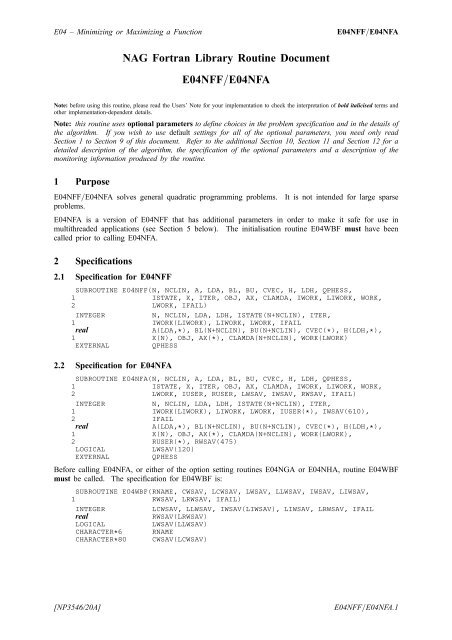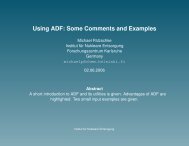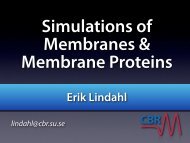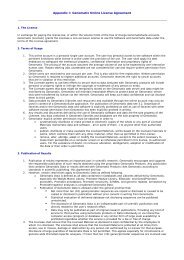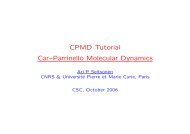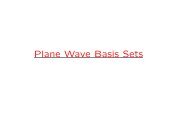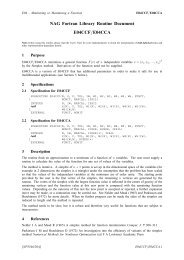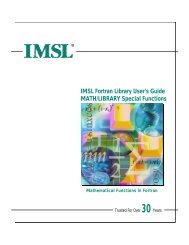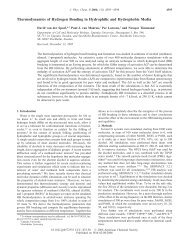NAG Fortran Library Routine Document E04NFF=E04NFA
NAG Fortran Library Routine Document E04NFF=E04NFA
NAG Fortran Library Routine Document E04NFF=E04NFA
Create successful ePaper yourself
Turn your PDF publications into a flip-book with our unique Google optimized e-Paper software.
E04 – Minimizing or Maximizing a Function<strong>E04NFF=E04NFA</strong><strong>NAG</strong> <strong>Fortran</strong> <strong>Library</strong> <strong>Routine</strong> <strong>Document</strong><strong>E04NFF=E04NFA</strong>Note: before using this routine, please read the Users’ Note for your implementation to check the interpretation of bold italicised terms andother implementation-dependent details.Note: this routine uses optional parameters to define choices in the problem specification and in the details ofthe algorithm. If you wish to use default settings for all of the optional parameters, you need only readSection 1 to Section 9 of this document. Refer to the additional Section 10, Section 11 and Section 12 for adetailed description of the algorithm, the specification of the optional parameters and a description of themonitoring information produced by the routine.1 Purpose<strong>E04NFF=E04NFA</strong> solves general quadratic programming problems. It is not intended for large sparseproblems.E04NFA is a version of E04NFF that has additional parameters in order to make it safe for use inmultithreaded applications (see Section 5 below). The initialisation routine E04WBF must have beencalled prior to calling E04NFA.2 Specifications2.1 Specification for E04NFFSUBROUTINE E04NFF(N, NCLIN, A, LDA, BL, BU, CVEC, H, LDH, QPHESS,1 ISTATE, X, ITER, OBJ, AX, CLAMDA, IWORK, LIWORK, WORK,2 LWORK, IFAIL)INTEGER N, NCLIN, LDA, LDH, ISTATE(N+NCLIN), ITER,1 IWORK(LIWORK), LIWORK, LWORK, IFAILreal A(LDA,*), BL(N+NCLIN), BU(N+NCLIN), CVEC(*), H(LDH,*),1 X(N), OBJ, AX(*), CLAMDA(N+NCLIN), WORK(LWORK)EXTERNALQPHESS2.2 Specification for E04NFASUBROUTINE E04NFA(N, NCLIN, A, LDA, BL, BU, CVEC, H, LDH, QPHESS,1 ISTATE, X, ITER, OBJ, AX, CLAMDA, IWORK, LIWORK, WORK,2 LWORK, IUSER, RUSER, LWSAV, IWSAV, RWSAV, IFAIL)INTEGER N, NCLIN, LDA, LDH, ISTATE(N+NCLIN), ITER,1 IWORK(LIWORK), LIWORK, LWORK, IUSER(*), IWSAV(610),2 IFAILreal A(LDA,*), BL(N+NCLIN), BU(N+NCLIN), CVEC(*), H(LDH,*),1 X(N), OBJ, AX(*), CLAMDA(N+NCLIN), WORK(LWORK),2 RUSER(*), RWSAV(475)LOGICALLWSAV(120)EXTERNALQPHESSBefore calling E04NFA, or either of the option setting routines E04NGA or E04NHA, routine E04WBFmust be called. The specification for E04WBF is:SUBROUTINE E04WBF(RNAME, CWSAV, LCWSAV, LWSAV, LLWSAV, IWSAV, LIWSAV,1 RWSAV, LRWSAV, IFAIL)INTEGER LCWSAV, LLWSAV, IWSAV(LIWSAV), LIWSAV, LRWSAV, IFAILrealRWSAV(LRWSAV)LOGICALLWSAV(LLWSAV)CHARACTER*6RNAMECHARACTER*80 CWSAV(LCWSAV)[NP3546/20A]<strong>E04NFF=E04NFA</strong>.1
<strong>E04NFF=E04NFA</strong><strong>NAG</strong> <strong>Fortran</strong> <strong>Library</strong> ManualE04WBF should be called with RNAME ¼ ’E04NFA’. LCWSAV, LLWSAV, LIWSAV and LRWSAV, thedeclared lengths of CWSAV, LWSAV, IWSAV and RWSAV respectively, must satisfy:LCWSAV 1LLWSAV 120LIWSAV 610LRWSAV 475The contents of the arrays CWSAV, LWSAV, IWSAV and RWSAV must not be altered between callingroutines E04WBF and E04NKA, E04NLA or E04NMA.3 Description<strong>E04NFF=E04NFA</strong> is designed to solve a class of quadratic programming problems that are assumed to bestated in the following general form: xminimize fðxÞ subject to l u;x2R n Axwhere A is an m L by n matrix and fðxÞ may be specified in a variety of ways depending upon theparticular problem to be solved. The available forms for fðxÞ are listed in Table 1 below, in which theprefixes FP, LP and QP stand for ‘feasible point’, ‘linear programming’ and ‘quadratic programming’respectively and c is an n element vector.Problem type fðxÞ Matrix HFP Not applicable Not applicableLP c T x Not applicableQP1 12 xT Hx symmetricQP2 c T x þ 1 2 xT Hx symmetricQP3 12 xT H T Hx m by n upper trapezoidalQP4 c T x þ 1 2 xT H T Hx m by n upper trapeziodalTable 1There is no restriction on H or H T H apart from symmetry. If the quadratic function is convex, a globalminimum is found; otherwise, a local minimum is found. The default problem type is QP2 and otherobjective functions are selected by using the optional parameter Problem Type (see Section 11.2). Forproblems of type FP, the objective function is omitted and the routine attempts to find a feasible point forthe set of constraints.The constraints involving A are called the general constraints. Note that upper and lower bounds arespecified for all the variables and for all the general constraints. An equality constraint can be specified bysetting l i ¼ u i . If certain bounds are not present, the associated elements of l or u can be set to specialvalues that will be treated as 1 or þ1. (See the description of the optional parameter Infinite BoundSize in Section 11.2.)The defining feature of a quadratic function fðxÞ is that the second-derivative matrix r 2 fðxÞ (the Hessianmatrix) is constant. For QP1 and QP2 (the default), r 2 fðxÞ ¼H; for QP3 and QP4, r 2 fðxÞ ¼H T H;and for the LP case, r 2 fðxÞ ¼0. If H is positive semi-definite, it is usually more efficient to useE04NCF=E04NCA. If H is defined as the zero matrix, <strong>E04NFF=E04NFA</strong> will still attempt to solve theresulting linear programming problem; however, this can be accomplished more efficiently by setting theoptional parameter Problem Type ¼ LP (see Section 11.2), or by using E04MFF=E04MFA instead.You must supply an initial estimate of the solution.In the QP case, you may supply H either explicitly as an m by n matrix, or implicitly in a subroutine thatcomputes the product Hx or H T Hx for any given vector x.<strong>E04NFF=E04NFA</strong>.2[NP3546/20A]
E04 – Minimizing or Maximizing a Function<strong>E04NFF=E04NFA</strong>In general, a successful run of <strong>E04NFF=E04NFA</strong> will indicate one of three situations:(i) a minimizer has been found;(ii) the algorithm has terminated at a so-called dead-point; or(iii) the problem has no bounded solution.If a minimizer is found, and r 2 fðxÞ is positive-definite or positive semi-definite, <strong>E04NFF=E04NFA</strong> willobtain a global minimizer; otherwise, the solution will be a local minimizer (which may or may not be aglobal minimizer). A dead-point is a point at which the necessary conditions for optimality are satisfiedbut the sufficient conditions are not. At such a point, a feasible direction of decrease may or may not exist,so that the point is not necessarily a local solution of the problem. Verification of optimality in suchinstances requires further information, and is in general an NP-hard problem (see Pardalos and Schnitger(1988)). Termination at a dead-point can occur only if r 2 fðxÞ is not positive-definite. If r 2 fðxÞ ispositive semi-definite, the dead-point will be a weak minimizer (i.e., with a unique optimal objective value,but an infinite set of optimal x).The method used by <strong>E04NFF=E04NFA</strong> (see Section 10) is most efficient when many constraints or boundsare active at the solution.4 ReferencesGill P E, Hammarling S, Murray W, Saunders M A and Wright M H (1986) User’s guide for LSSOL(Version 1.0) Report SOL 86-1 Department of Operations Research, Stanford UniversityGill P E and Murray W (1978) Numerically stable methods for quadratic programming Math.Programming 14 349–372Gill P E, Murray W, Saunders M A and Wright M H (1984) Procedures for optimization problems with amixture of bounds and general linear constraints ACM Trans. Math. Software 10 282–298Gill P E, Murray W, Saunders M A and Wright M H (1989) A practical anti-cycling procedure for linearlyconstrained optimization Math. Programming 45 437–474Gill P E, Murray W, Saunders M A and Wright M H (1991) Inertia-controlling methods for generalquadratic programming SIAM Rev. 33 1–36Pardalos P M and Schnitger G (1988) Checking local optimality in constrained quadratic programming isNP-hard Operations Research Letters 7 33–35Gill P E, Murray W and Wright M H (1981) Practical Optimization Academic Press5 Parameters1: N – INTEGER InputOn entry: n, the number of variables.Constraint: N> 0.2: NCLIN – INTEGER InputOn entry: m L , the number of general linear constraints.Constraint: NCLIN 0.3: A(LDA,*) – real array InputNote: the second dimension of the array A must be at least N when NCLIN > 0, and at least 1when NCLIN ¼ 0.On entry: the ith row of A must contain the coefficients of the ith general linear constraint, fori ¼ 1; 2; ...;m L .If NCLIN ¼ 0, A is not referenced.[NP3546/20A]<strong>E04NFF=E04NFA</strong>.3
<strong>E04NFF=E04NFA</strong><strong>NAG</strong> <strong>Fortran</strong> <strong>Library</strong> Manual4: LDA – INTEGER InputOn entry: the first dimension of the array A as declared in the (sub)program from which<strong>E04NFF=E04NFA</strong> is called.Constraint: LDA maxð1; NCLINÞ.5: BL(N+NCLIN) – real array Input6: BU(N+NCLIN) – real array InputOn entry: BL must contain the lower bounds and BU the upper bounds, for all the constraints in thefollowing order. The first n elements of each array must contain the bounds on the variables, andthe next m L elements the bounds for the general linear constraints (if any). To specify a nonexistentlower bound (i.e., l j ¼ 1), set BLðjÞ bigbnd, and to specify a non-existent upperbound (i.e., u j ¼þ1), set BUðjÞ bigbnd; the default value of bigbnd is 10 20 , but this may bechanged by the optional parameter Infinite Bound Size (see Section 11.2). To specify the jthconstraint as an equality, set BLðjÞ ¼BUðjÞ ¼, say, where jj < bigbnd.Constraints:BLðjÞ BUðjÞ, for j ¼ 1; 2; ...; N þ NCLIN,jj < bigbnd when BLðjÞ ¼BUðjÞ ¼.7: CVEC(*) –real array InputNote: the first dimension of the array CVEC must be at least N when the problem is of type LP,QP2 (the default) or QP4, and at least 1 otherwise.On entry: the coefficients of the explicit linear term of the objective function when the problem is oftype LP, QP2 (the default) and QP4.If the problem is of type FP, QP1, or QP3, CVEC is not referenced.8: H(LDH,*) – real array InputNote: the second dimension of the array H must be at least N if it is to be used to store Hexplicitly, and at least 1 otherwise.On entry: H may be used to store the quadratic term H of the QP objective function if desired. Insome cases, the user need not use H to store H explicitly (see the specification of subroutineQPHESS below). The elements of H are referenced only by subroutine QPHESS. The number ofrows of H is denoted by m, whose default value is n. (The optional parameter Hessian Rows maybe used to specify a value of m
E04 – Minimizing or Maximizing a Function<strong>E04NFF=E04NFA</strong>In other situations, it may be desirable to compute Hx or H T Hx without accessing H – forexample, if H or H T H is sparse or has special structure. The parameters H and LDH may thenrefer to any convenient array.If the problem is of type FP or LP, H is not referenced.9: LDH – INTEGER InputOn entry: the first dimension of the array H as declared in the (sub)program from which<strong>E04NFF=E04NFA</strong> is called.Constraints:if the problem is of type QP1, QP2 (the default), QP3 or QP4, LDH N or at least the valueof the optional parameter Hessian Rows (default value ¼ n; see Section 11.2);if the problem is of type FP or LP, LDH 1.10: QPHESS – SUBROUTINE, supplied by the <strong>NAG</strong> <strong>Fortran</strong> <strong>Library</strong> or the user. External ProcedureIn general, you need not provide a version of QPHESS, because a ‘default’ subroutine with nameE04NFU=E54NFU is included in the <strong>Library</strong> (NFUE04=NFUE54 in some implementations: see theUsers’ Note for your implementation for details). However, the algorithm of <strong>E04NFF=E04NFA</strong>requires only the product of H or H T H and a vector x; and in some cases you may obtainincreased efficiency by providing a version of QPHESS that avoids the need to define the elementsof the matrices H or H T H explicitly.QPHESS is not referenced if the problem is of type FP or LP, in which case QPHESS may be theroutine E04NFU=E54NFU (NFUE04=NFUE54 in some implementations).The specification of QPHESS for E04NFF is:SUBROUTINE FUNCT(N, JTHCOL, H, LDH, X, HX)INTEGER N, JTHCOL, LDHreal H(LDH,*), X(N), HX(N)The specification of QPHESS for E04NFA is:SUBROUTINE FUNCT(N, JTHCOL, H, LDH, X, HX, IUSER, RUSER)INTEGER N, JTHCOL, LDH, IUSER(*)real H(LDH,*), X(N), HX(N), RUSER(*)1: N – INTEGER InputOn entry: this is the same parameter N as supplied to <strong>E04NFF=E04NFA</strong> (see above).2: JTHCOL – INTEGER InputOn entry: JTHCOL specifies whether or not the vector x is a column of the identitymatrix. If JTHCOL ¼ j>0, then the vector x is the jth column of the identity matrix,and hence Hx or H T Hx is the jth column of H or H T H, respectively. This may in somecases require very little computation and QPHESS may be coded to take advantage of this.However special code is not necessary because x is always stored explicitly in the array X.If JTHCOL ¼ 0, x has no special form.3: H(LDH,*) – real array InputOn entry: this is the same parameter H as supplied to <strong>E04NFF=E04NFA</strong> (see above).4: LDH – INTEGER InputOn entry: this is the same parameter LDH as supplied to <strong>E04NFF=E04NFA</strong> (see above).5: X(N) – real array InputOn entry: the vector x.[NP3546/20A]<strong>E04NFF=E04NFA</strong>.5
<strong>E04NFF=E04NFA</strong><strong>NAG</strong> <strong>Fortran</strong> <strong>Library</strong> Manual6: HX(N) – real array OutputOn exit: the product Hx if the problem is of type QP1 or QP2 (the default), or the productH T Hx if the problem is of type QP3 or QP4.Note: the following are additional parameters for specific use of QPHESS with E04NFA.E04NFF therefore need not read the remainder of this description.Users of7: IUSER(*) – INTEGER array User Workspace8: RUSER(*) –real array User WorkspaceQPHESS is called from E04NFA with the parameters IUSER and RUSER as supplied toE04NFA. You are free to use the arrays IUSER and RUSER to supply information toQPHESS.QPHESS must be declared as EXTERNAL in the (sub)program from which <strong>E04NFF=E04NFA</strong> iscalled. Parameters denoted as Input must not be changed by this procedure.11: ISTATE(N+NCLIN) – INTEGER array Input/OutputOn entry: ISTATE need not be set if the (default) Cold Start option is used.If the Warm Start option has been chosen (see Section 11.2), ISTATE specifies the desired status ofthe constraints at the start of the feasibility phase. More precisely, the first n elements of ISTATErefer to the upper and lower bounds on the variables, and the next m L elements refer to the generallinear constraints (if any). Possible values for ISTATEðjÞ are as follows:ISTATEðjÞMeaning0 The corresponding constraint should not be in the initial working set.1 The constraint should be in the initial working set at its lower bound.2 The constraint should be in the initial working set at its upper bound.3 The constraint should be in the initial working set as an equality. This value must notbe specified unless BLðjÞ ¼BUðjÞ.The values 2, 1 and 4 are also acceptable but will be reset to zero by the routine. If<strong>E04NFF=E04NFA</strong> has been called previously with the same values of N and NCLIN, ISTATEalready contains satisfactory information. (See also the description of the optional parameter WarmStart in Section 11.2.) The routine also adjusts (if necessary) the values supplied in X to beconsistent with ISTATE.Constraint: 2 ISTATEðjÞ 4, for j ¼ 1; 2; ...; N þ NCLIN.On exit: the status of the constraints in the working set at the point returned in X. The significanceof each possible value of ISTATEðjÞ is as follows:ISTATEðjÞMeaning2 The constraint violates its lower bound by more than the feasibility tolerance.1 The constraint violates its upper bound by more than the feasibility tolerance.0 The constraint is satisfied to within the feasibility tolerance, but is not in the workingset.1 This inequality constraint is included in the working set at its lower bound.2 This inequality constraint is included in the working set at its upper bound.3 This constraint is included in the working set as an equality. This value of ISTATEcan occur only when BLðjÞ ¼BUðjÞ.4 This corresponds to optimality being declared with XðjÞ being temporarily fixed at itscurrent value. This value of ISTATE can occur only when IFAIL ¼ 1 on exit.<strong>E04NFF=E04NFA</strong>.6[NP3546/20A]
E04 – Minimizing or Maximizing a Function<strong>E04NFF=E04NFA</strong>12: X(N) – real array Input/OutputOn entry: an initial estimate of the solution.On exit: the point at which <strong>E04NFF=E04NFA</strong> terminated. If IFAIL ¼ 0, 1 or 3, X contains anestimate of the solution.13: ITER – INTEGER OutputOn exit: the total number of iterations performed.14: OBJ – real OutputOn exit: the value of the objective function at x if x is feasible, or the sum of infeasibilities at xotherwise. If the problem is of type FP and x is feasible, OBJ is set to zero.15: AX(*) –real array OutputNote: the first dimension of the array AX must be at least maxð1; NCLINÞ.On exit: the final values of the linear constraints Ax.If NCLIN ¼ 0, AX is not referenced.16: CLAMDA(N+NCLIN) – real array OutputOn exit: the values of the Lagrange multipliers for each constraint with respect to the currentworking set. The first n elements contain the multipliers for the bound constraints on the variables,and the next m L elements contain the multipliers for the general linear constraints (if any). IfISTATEðjÞ ¼0 (i.e., constraint j is not in the working set), CLAMDAðjÞ is zero. If x is optimal,CLAMDAðjÞ should be non-negative if ISTATEðjÞ ¼1, non-positive if ISTATEðjÞ ¼2 and zero ifISTATEðjÞ ¼4.17: IWORK(LIWORK) – INTEGER array Workspace18: LIWORK – INTEGER InputOn entry: the first dimension of the array IWORK as declared in the (sub)program from which<strong>E04NFF=E04NFA</strong> is called.Constraint: LIWORK 2 N þ 3.19: WORK(LWORK) – real array Workspace20: LWORK – INTEGER InputOn entry: the first dimension of the array WORK as declared in the (sub)program from which<strong>E04NFF=E04NFA</strong> is called.Constraints:For problems QP2 (the default) and QP4,LWORK 2 N 2 þ 8 N þ 5 NCLIN if NCLIN > 0,LWORK N 2 þ 8 N if NCLIN ¼ 0.For problems QP1 and QP3,LWORK 2 N 2 þ 7 N þ 5 NCLIN if NCLIN > 0,LWORK N 2 þ 7 N if NCLIN ¼ 0.If the problem is of type LP,LWORK 8 N þ 1 if NCLIN ¼ 0,LWORK 2 N 2 þ 8 N þ 5 NCLIN if NCLIN N,LWORK 2 ðNCLIN þ 1Þ 2 þ 8 N þ 5 NCLIN otherwise.[NP3546/20A]<strong>E04NFF=E04NFA</strong>.7
<strong>E04NFF=E04NFA</strong><strong>NAG</strong> <strong>Fortran</strong> <strong>Library</strong> ManualIf the problem is of type FP,LWORK 7 N þ 1 if NCLIN ¼ 0,LWORK 2 N 2 þ 7 N þ 5 NCLIN if NCLIN N,LWORK 2 ðNCLIN þ 1Þ 2 þ 7 N þ 5 NCLIN otherwise.The amounts of workspace provided and required are (by default) output on the current advisorymessage unit (as defined by X04ABF). As an alternative to computing LIWORK and LWORKfrom the formulas given above, the user may prefer to obtain appropriate values from the output of apreliminary run with LIWORK and LWORK set to 1. (<strong>E04NFF=E04NFA</strong> will then terminate withIFAIL ¼ 6.)21: IFAIL – INTEGER Input/OutputNote: for E04NFA, IFAIL does not occur in this position in the parameter list.parameters described below.See the additionalOn entry: IFAIL must be set to 0, 1 or 1. Users who are unfamiliar with this parameter shouldrefer to Chapter P01 for details.On exit: IFAIL ¼ 0 unless the routine detects an error (see Section 6).For environments where it might be inappropriate to halt program execution when an error isdetected, the value 1 or 1 is recommended. If the output of error messages is undesirable, then thevalue 1 is recommended. Otherwise, because for this routine the values of the output parametersmay be useful even if IFAIL 6¼ 0 on exit, the recommended value is 1. When the value 1 or 1is used it is essential to test the value of IFAIL on exit.<strong>E04NFF=E04NFA</strong> returns with IFAIL ¼ 0ifx is a strong local minimizer, i.e., the reduced gradient(Norm Gz; see Section 8.2) is negligible, the Lagrange multipliers (Lagr Mult; see Section 8.2) areoptimal and H R (the reduced Hessian of fðxÞ; see Section 10.2) is positive semi-definite.Note: the following are additional parameters for specific use with E04NFA. Users of E04NFF therefore neednot read the remainder of this section.21: IUSER(*) – INTEGER array User WorkspaceNote: the dimension of the array IUSER must be at least 1.IUSER is not used by E04NFA, but is passed directly to the external procedure QPHESS and maybe used to pass information to that routine.22: RUSER(*) –real array User WorkspaceNote: the dimension of the array RUSER must be at least 1.RUSER is not used by E04NFA, but is passed directly to the external procedure QPHESS and maybe used to pass information to that routine.23: LWSAV(120) – LOGICAL array Workspace24: IWSAV(610) – INTEGER array Workspace25: RWSAV(475) – real array WorkspaceThe arrays LWSAV, IWSAV and RWSAV must not be altered between calls to any of the routinesE04WBF, E04NFA, E04NGA or E04NHA.26: IFAIL – INTEGER Input/OutputNote: see the parameter description for IFAIL above.<strong>E04NFF=E04NFA</strong>.8[NP3546/20A]
E04 – Minimizing or Maximizing a Function<strong>E04NFF=E04NFA</strong>6 Error Indicators and WarningsIf on entry IFAIL ¼ 0or 1, explanatory error messages are output on the current error message unit (asdefined by X04AAF).Errors or warnings detected by the routine:IFAIL ¼ 1The iterations were terminated at a dead-point. The necessary conditions for optimality are satisfiedbut the sufficient conditions are not. (The reduced gradient is negligible, the Lagrange multipliersare optimal, but H R is singular or there are some very small multipliers.) If r 2 fðxÞ is not positivedefinite,x is not necessarily a local solution of the problem and verification of optimality requiresfurther information. If r 2 fðxÞ is positive semi-definite or the problem is of type LP, x gives theglobal minimum value of the objective function, but the final x is not unique.IFAIL ¼ 2The solution appears to be unbounded, i.e., the objective function is not bounded below in thefeasible region. This value of IFAIL occurs if a step larger than Infinite Step Size(default value ¼ 10 20 ; see Section 11.2) would have to be taken in order to continue the algorithm,or the next step would result in an element of x having magnitude larger than Infinite Bound Size(default value ¼ 10 20 ; see Section 11.2).IFAIL ¼ 3No feasible point was found, i.e., it was not possible to satisfy all the constraints to within thefeasibility tolerance. In this case, the constraint violations at the final x will reveal a value of thetolerance for which a feasible point will exist – for example, when the feasibility tolerance for eachviolated constraint exceeds its Slack (see Section 8.2) at the final point. The modified problem(with an altered feasibility tolerance) may then be solved using a Warm Start (see Section 11.2).You should check that there are no constraint redundancies. If the data for the constraints areaccurate only to the absolute precision , the userpshould ensure that the value of the optionalparameter Feasibility Tolerance (default value ¼ffiffi , where is the machine precision; seeSection 11.2) is greater than . For example, if all elements of A are of order unity and are accurateonly to three decimal places, the optional parameter Feasibility Tolerance should be at least 10 3 .IFAIL ¼ 4The limiting number of iterations was reached before normal termination occurred.The values of the optional parameters Feasibility Phase Iteration Limit(default value ¼ maxð50; 5ðn þ m L ÞÞ; see Section 11.2) and Optimality Phase Iteration Limit(default value ¼ maxð50; 5ðn þ m L ÞÞ; see Section 11.2) may be too small. If the method appears tobe making progress (e.g., the objective function is being satisfactorily reduced), either increase theiterations limit and rerun <strong>E04NFF=E04NFA</strong> or, alternatively, rerun <strong>E04NFF=E04NFA</strong> using theWarm Start facility to specify the initial working set.IFAIL ¼ 5The reduced Hessian exceeds its assigned dimension. The algorithm needed to expand the reducedHessian when it was already at its maximum dimension, as specified by the optional parameterMaximum Degrees of Freedom (default value ¼ n; see Section 11.2).The value of the parameter Maximum Degrees of Freedom is too small. Rerun <strong>E04NFF=E04NFA</strong>with a larger value (possibly using the Warm Start facility to specify the initial working set).IFAIL ¼ 6An input parameter is invalid.[NP3546/20A]<strong>E04NFF=E04NFA</strong>.9
<strong>E04NFF=E04NFA</strong><strong>NAG</strong> <strong>Fortran</strong> <strong>Library</strong> ManualIFAIL ¼ 7The designated problem type was not FP, LP, QP1, QP2, QP3 or QP4. Rerun <strong>E04NFF=E04NFA</strong>with the optional parameter Problem Type (see Section 11.2) set to one of these values.IFAIL ¼ OverflowIf the printed output before the overflow error contains a warning about serious ill-conditioning inthe working set when adding the jth constraint, it may be possible to avoid the difficultypbyincreasing the magnitude of the optional parameter Feasibility Tolerance (default value ¼ffiffi ,where is the machine precision; see Section 11.2) and rerunning the program. If the messagerecurs even after this change, the offending linearly dependent constraint (with index ‘j’) must beremoved from the problem.7 AccuracyThe routine implements a numerically stable active set strategy and returns solutions that are as accurate asthe condition of the problem warrants on the machine.8 Further CommentsThis section contains some comments on scaling and a description of the printed output.8.1 ScalingSensible scaling of the problem is likely to reduce the number of iterations required and make the problemless sensitive to perturbations in the data, thus improving the condition of the problem. In the absence ofbetter information it is usually sensible to make the Euclidean lengths of each constraint of comparablemagnitude. See the E04 Chapter Introduction and Gill et al. (1981) for further information and advice.8.2 Description of the Printed OutputThis section describes the intermediate printout and final printout produced by <strong>E04NFF=E04NFA</strong>. Theintermediate printout is a subset of the monitoring information produced by the routine at every iteration(see Section 12). The level of printed output can be controlled by the user (see the description of theoptional parameter Print Level in Section 11.2). Note that the intermediate printout and final printout areproduced only if Print Level 10 (the default for E04NFF, by default no output is produced byE04NFA).The following line of summary output (< 80 characters) is produced at every iteration. In all cases, thevalues of the quantities printed are those in effect on completion of the given iteration.Itnis the iteration count.Stepis the step taken along the computed search direction. If a constraint is added duringthe current iteration, Step will be the step to the nearest constraint. When theproblem is of type LP, the step can be greater than one during the optimality phase.Ninf is the number of violated constraints (infeasibilities). This will be zero during theoptimality phase.Sinf/Objective is the value of the current objective function. If x is not feasible, Sinf gives aweighted sum of the magnitudes of constraint violations. If x is feasible, Objectiveis the value of the objective function of (1). The output line for the final iteration ofthe feasibility phase (i.e., the first iteration for which Ninf is zero) will give the valueof the true objective at the first feasible point.During the optimality phase the value of the objective function will be nonincreasing.During the feasibility phase the number of constraint infeasibilities willnot increase until either a feasible point is found or the optimality of the multipliersimplies that no feasible point exists. Once optimal multipliers are obtained the<strong>E04NFF=E04NFA</strong>.10[NP3546/20A]
E04 – Minimizing or Maximizing a Function<strong>E04NFF=E04NFA</strong>number of infeasibilities can increase, but the sum of infeasibilities will either remainconstant or be reduced until the minimum sum of infeasibilities is found.Norm Gzis kZRg T FR k, the Euclidean norm of the reduced gradient with respect to Z R . Duringthe optimality phase, this norm will be approximately zero after a unit step. (SeeSection 10.2 and Section 10.3.)The final printout includes a listing of the status of every variable and constraint.The following describes the printout for each variable. A full stop (.) is printed for any numerical valuethat is zero.Varblgives the name (V) and index j, for j ¼ 1; 2; ...;n of the variable.Stategives the state of the variable (FR if neither bound is in the working set, EQ if a fixedvariable, LL if on its lower bound, UL if on its upper bound, TF if temporarily fixed atits current value). If Value lies outsidepthe upper or lower bounds by more than theFeasibility Tolerance (default value ¼ffiffi , where is the machine precision; seeSection 11.2), State will be ++ or respectively.A key is sometimes printed before State to give some additional information aboutthe state of a variable.A Alternative optimum possible. The variable is active at one of its bounds, butits Lagrange multiplier is essentially zero. This means that if the variable wereallowed to start moving away from its bound then there would be no change tothe objective function. The values of the other free variables might change,giving a genuine alternative solution. However, if there are any degeneratevariables (labelled D), the actual change might prove to be zero, since one ofthem could encounter a bound immediately. In either case the values of theLagrange multipliers might also change.D Degenerate. The variable is free, but it is equal to (or very close to) one of itsbounds.I Infeasible. The variable is currently violating one of its bounds by more thanthe Feasibility Tolerance.Valueis the value of the variable at the final iteration.Lower Bound is the lower bound specified for the variable. None indicates that BLðjÞ bigbnd.Upper Bound is the upper bound specified for the variable. None indicates that BUðjÞ bigbnd.Lagr Mult is the Lagrange multiplier for the associated bound. This will be zero if State is FRunless BLðjÞ bigbnd and BUðjÞ bigbnd, in which case the entry will be blank.If x is optimal, the multiplier should be non-negative if State is LL and non-positiveif State is UL.Slackis the difference between the variable Value and the nearer of its (finite) boundsBLðjÞ and BUðjÞ. A blank entry indicates that the associated variable is not bounded(i.e., BLðjÞ bigbnd and BUðjÞ bigbnd).The meaning of the printout for general constraints is the same as that given above for variables, with‘variable’ replaced by ‘constraint’, BLðjÞ and BUðjÞ are replaced by BLðn þ jÞ and BUðn þ jÞrespectively, and with the following change in the heading:L Congives the name (L) and index j, for j ¼ 1; 2; ...;n L of the linear constraint.Note that movement off a constraint (as opposed to a variable moving away from its bound) can beinterpreted as allowing the entry in the Slack column to become positive.Numerical values are output with a fixed number of digits; they are not guaranteed to be accurate to thisprecision.[NP3546/20A]<strong>E04NFF=E04NFA</strong>.11
E04 – Minimizing or Maximizing a Function<strong>E04NFF=E04NFA</strong>PARAMETER(LIWORK=1000,LWORK=10000)* .. Local Scalars ..realOBJINTEGER I, IFAIL, ITER, J, N, NCLIN* .. Local Arrays ..real A(LDA,NMAX), AX(NCMAX), BL(NMAX+NCMAX),+ BU(NMAX+NCMAX), CLAMDA(NMAX+NCMAX), CVEC(NMAX),+ H(LDH,NMAX), WORK(LWORK), X(NMAX)INTEGER ISTATE(NMAX+NCMAX), IWORK(LIWORK)* .. External Subroutines ..EXTERNAL E04NFF, E04NFU* .. Executable Statements ..WRITE (NOUT,*) ’E04NFF Example Program Results’* Skip heading in data fileREAD (NIN,*)READ (NIN,*) N, NCLINIF (N.LE.NMAX .AND. NCLIN.LE.NCMAX) THEN** Read CVEC, A, BL, BU, X and H from data file*READ (NIN,*) (CVEC(I),I=1,N)READ (NIN,*) ((A(I,J),J=1,N),I=1,NCLIN)READ (NIN,*) (BL(I),I=1,N+NCLIN)READ (NIN,*) (BU(I),I=1,N+NCLIN)READ (NIN,*) (X(I),I=1,N)READ (NIN,*) ((H(I,J),J=1,N),I=1,N)** Solve the problem*IFAIL = -1*CALL E04NFF(N,NCLIN,A,LDA,BL,BU,CVEC,H,LDH,E04NFU,ISTATE,X,+ ITER,OBJ,AX,CLAMDA,IWORK,LIWORK,WORK,LWORK,IFAIL)*END IFSTOPEND9.2 Program DataE04NFF Example Program Data7 7 :Values of N and NCLIN-0.02 -0.20 -0.20 -0.20 -0.20 0.04 0.04 :End of CVEC1.00 1.00 1.00 1.00 1.00 1.00 1.000.15 0.04 0.02 0.04 0.02 0.01 0.030.03 0.05 0.08 0.02 0.06 0.01 0.000.02 0.04 0.01 0.02 0.02 0.00 0.000.02 0.03 0.00 0.00 0.01 0.00 0.000.70 0.75 0.80 0.75 0.80 0.97 0.000.02 0.06 0.08 0.12 0.02 0.01 0.97 :End of matrix A-0.01 -0.10 -0.01 -0.04 -0.10 -0.01 -0.01-0.13 -1.0e+25 -1.0e+25 -1.0e+25 -1.0e+25 -9.92e-02 -3.0e-03 :End of BL0.01 0.15 0.03 0.02 0.05 1.0e+25 1.0e+25-0.13 -4.9e-03 -6.4e-03 -3.7e-03 -1.2e-03 1.0e+25 2.0e-03 :End of BU-0.01 -0.03 0.00 -0.01 -0.10 0.02 0.01 :End of X2.00 0.00 0.00 0.00 0.00 0.00 0.000.00 2.00 0.00 0.00 0.00 0.00 0.000.00 0.00 2.00 2.00 0.00 0.00 0.000.00 0.00 2.00 2.00 0.00 0.00 0.000.00 0.00 0.00 0.00 2.00 0.00 0.000.00 0.00 0.00 0.00 0.00 -2.00 -2.000.00 0.00 0.00 0.00 0.00 -2.00 -2.00 :End of matrix H[NP3546/20A]<strong>E04NFF=E04NFA</strong>.13
<strong>E04NFF=E04NFA</strong><strong>NAG</strong> <strong>Fortran</strong> <strong>Library</strong> Manual9.3 Program ResultsE04NFF Example Program Results*** E04NFF*** Start of <strong>NAG</strong> <strong>Library</strong> implementation details ***Implementation title: Generalised Base VersionPrecision: FORTRAN double precisionProduct Code: FLBAS20DMark: 20A*** End of <strong>NAG</strong> <strong>Library</strong> implementation details ***Parameters----------Problem type........... QP2Linear constraints..... 7 Feasibility tolerance.. 1.05E-08Variables.............. 7 Optimality tolerance... 1.72E-13Hessian rows........... 7 Rank tolerance......... 1.11E-14Infinite bound size.... 1.00E+20 COLD start.............Infinite step size..... 1.00E+20 EPS (machine precision) 1.11E-16Check frequency........ 50 Expand frequency....... 5Minimum sum of infeas.. NO Crash tolerance........ 1.00E-02Max degrees of freedom. 7 Print level............ 10Feasibility phase itns. 70 Monitoring file........ -1Optimality phase itns. 70Workspace provided is IWORK( 1000), WORK( 10000).To solve problem we need IWORK( 17), WORK( 189).Itn Step Ninf Sinf/Objective Norm Gz0 0.0E+00 3 1.038000E-01 0.0E+001 4.1E-02 1 3.000000E-02 0.0E+002 4.2E-02 0 0.000000E+00 0.0E+00Itn 2 -- Feasible point found.2 0.0E+00 0 4.580000E-02 0.0E+003 1.3E-01 0 4.161596E-02 0.0E+004 1.0E+00 0 3.936227E-02 1.6E-175 4.1E-01 0 3.758935E-02 1.2E-026 1.0E+00 0 3.755377E-02 6.9E-187 1.0E+00 0 3.703165E-02 3.1E-17Varbl State Value Lower Bound Upper Bound Lagr Mult SlackV 1 LL -1.000000E-02 -1.000000E-02 1.000000E-02 0.4700 .V 2 FR -6.986465E-02 -0.100000 0.150000 . 3.0135E-02V 3 FR 1.825915E-02 -1.000000E-02 3.000000E-02 . 1.1741E-02V 4 FR -2.426081E-02 -4.000000E-02 2.000000E-02 . 1.5739E-02V 5 FR -6.200564E-02 -0.100000 5.000000E-02 . 3.7994E-02V 6 FR 1.380544E-02 -1.000000E-02 None . 2.3805E-02V 7 FR 4.066496E-03 -1.000000E-02 None . 1.4066E-02L Con State Value Lower Bound Upper Bound Lagr Mult SlackL 1 EQ -0.130000 -0.130000 -0.130000 -1.908 -2.7756E-17L 2 FR -5.879898E-03 None -4.900000E-03 . 9.7990E-04L 3 UL -6.400000E-03 None -6.400000E-03 -0.3144 -1.7347E-18L 4 FR -4.537323E-03 None -3.700000E-03 . 8.3732E-04L 5 FR -2.915996E-03 None -1.200000E-03 . 1.7160E-03L 6 LL -9.920000E-02 -9.920000E-02 None 1.955 -4.1633E-17L 7 LL -3.000000E-03 -3.000000E-03 2.000000E-03 1.972 1.7347E-18<strong>E04NFF=E04NFA</strong>.14[NP3546/20A]
E04 – Minimizing or Maximizing a Function<strong>E04NFF=E04NFA</strong>Exit E04NFF - Optimal QP solution.Final QP objective value = 0.3703165E-01Exit from QP problem after 7 iterations.Note: the remainder of this document is intended for more advanced users. Section 10 contains a detaileddescription of the algorithm which may be needed in order to understand Section 11 and Section 12. Section 11describes the optional parameters which may be set by calls to E04MGF=E04MGA and/or E04MHF=E04MHA.Section 12 describes the quantities which can be requested to monitor the course of the computation.10 Algorithmic DetailsThis section contains a detailed description of the method used by <strong>E04NFF=E04NFA</strong>.10.1 Overview<strong>E04NFF=E04NFA</strong> is based on an inertia-controlling method that maintains a Cholesky factorization of thereduced Hessian (see below). The method is based on that of Gill and Murray (1978), and is described indetail by Gill et al. (1991). Here we briefly summarize the main features of the method. Where possible,explicit reference is made to the names of variables that are parameters of <strong>E04NFF=E04NFA</strong> or appear inthe printed output. <strong>E04NFF=E04NFA</strong> has two phases: finding an initial feasible point by minimizing thesum of infeasibilities (the feasibility phase), and minimizing the quadratic objective function within thefeasible region (the optimality phase). The computations in both phases are performed by the samesubroutines. The two-phase nature of the algorithm is reflected by changing the function being minimizedfrom the sum of infeasibilities to the quadratic objective function. The feasibility phase does not performthe standard simplex method (i.e., it does not necessarily find a vertex), except in the LP case whenm L n. Once any iterate is feasible, all subsequent iterates remain feasible.<strong>E04NFF=E04NFA</strong> has been designed to be efficient when used to solve a sequence of related problems –for example, within a sequential quadratic programming method for nonlinearly constrained optimization(e.g., E04UCF=E04UCA or E04UFF=E04UFA). In particular, you may specify an initial working set (theindices of the constraints believed to be satisfied exactly at the solution); see the discussion of the optionalparameter Warm Start in Section 11.2.In general, an iterative process is required to solve a quadratic program. (For simplicity, we shall alwaysconsider a typical iteration and avoid reference to the index of the iteration.) Each new iterate x is definedbyx ¼ x þ pð1Þwhere the step length is a non-negative scalar and p is called the search direction.At each point x, a working set of constraints is defined to be a linearly independent subset of theconstraints that are satisfied ‘exactly’ (to within the tolerance defined by the optional parameter FeasibilityTolerance; see Section 11.2). The working set is the current prediction of the constraints that hold withequality at the solution of a linearly constrained QP problem. The search direction is constructed so thatthe constraints in the working set remain unaltered for any value of the step length. For a bound constraintin the working set, this property is achieved by setting the corresponding element of the search direction tozero. Thus, the associated variable is fixed, and specification of the working set induces a partition of xinto fixed and free variables. During a given iteration, the fixed variables are effectively removed from theproblem; since the relevant elements of the search direction are zero, the columns of A corresponding tofixed variables may be ignored.Let m W denote the number of general constraints in the working set and let n FX denote the number ofvariables fixed at one of their bounds (m W and n FX are the quantities Lin and Bnd in the monitoring fileoutput from <strong>E04NFF=E04NFA</strong>; see Section 12). Similarly, let n FR (n FR ¼ n n FX ) denote the number offree variables. At every iteration, the variables are re-ordered so that the last n FX variables are fixed, withall other relevant vectors and matrices ordered accordingly.[NP3546/20A]<strong>E04NFF=E04NFA</strong>.15
<strong>E04NFF=E04NFA</strong><strong>NAG</strong> <strong>Fortran</strong> <strong>Library</strong> Manual10.2 Definition of Search DirectionLet A FR denote the m W by n FR sub-matrix of general constraints in the working set corresponding to thefree variables and let p FR denote the search direction with respect to the free variables only. The generalconstraints in the working set will be unaltered by any move along p ifA FR p FR ¼ 0:ð2ÞIn order to compute p FR , the TQ factorization of A FR is used:A FR Q FR ¼ð0 TÞ; ð3Þwhere T is a non-singular m W by m W upper triangular matrix (i.e., t ij ¼ 0ifi>j), and the non-singularn FR by n FR matrix Q FR is the product of orthogonal transformations (see Gill et al. (1984)). If thecolumns of Q FR are partitioned so thatQ FR ¼ðZ YÞ;where Y is n FR by m W , then the n Z ðn Z ¼ n FR m W Þ columns of Z form a basis for the null space ofA FR . Let n R be an integer such that 0 n R n Z , and let Z R denote a matrix whose n R columns are asubset of the columns of Z. (The integer n R is the quantity Zr in the monitoring output from<strong>E04NFF=E04NFA</strong>. In many cases, Z R will include all the columns of Z.) The direction p FR will satisfy (2)ifp FR ¼ Z R p R ;ð4Þwhere p R is any n R -vector.Let Q denote the n by n matrixQ ¼Q FR;where I FX is the identity matrix of order n FX . Let H Q and g Q denote the n by n transformed Hessian andtransformed gradientI FXH Q ¼ Q T HQ and g Q ¼ Q T ðc þ HxÞand let the matrix of first n R rows and columns of H Q be denoted by H R and the vector of the first n Relements of g Q be denoted by g R . The quantities H R and g R are known as the reduced Hessian andreduced gradient of fðxÞ, respectively. Roughly speaking, g R and H R describe the first and secondderivatives of an unconstrained problem for the calculation of p R .At each iteration, a triangular factorization of H R is available. If H R is positive-definite, H R ¼ R T R,where R is the upper triangular Cholesky factor of H R . If H R is not positive-definite, H R ¼ R T DR,where D ¼ diagð1; 1; ...; 1;Þ, with 0.The computation is arranged so that the reduced-gradient vector is a multiple of e R , a vector of all zerosexcept in the last (i.e., n R th) position. This allows the vector p R in (4) to be computed from a single backsubstitutionRp R ¼ e Rð5Þwhere is a scalar that depends on whether or not the reduced Hessian is positive-definite at x. In thepositive-definite case, x þ p is the minimizer of the objective function subject to the constraints (boundsand general) in the working set treated as equalities. If H R is not positive-definite p R satisfies theconditionsp T RH R p R < 0 and g T Rp R 0;which allow the objective function to be reduced by any positive step of the form x þ p.<strong>E04NFF=E04NFA</strong>.16[NP3546/20A]
E04 – Minimizing or Maximizing a Function<strong>E04NFF=E04NFA</strong>10.3 Main IterationIf the reduced gradient is zero, x is a constrained stationary point in the subspace defined by Z. Duringthe feasibility phase, the reduced gradient will usually be zero only at a vertex (although it may be zero atnon-vertices in the presence of constraint dependencies). During the optimality phase a zero reducedgradient implies that x minimizes the quadratic objective when the constraints in the working set aretreated as equalities. At a constrained stationary point, Lagrange multipliers C and B for the general andbound constraints are defined from the equationsA T FR C ¼ g FR and B ¼ g FX A T FX C : ð6ÞGiven a positive constant of the order of the machine precision, a Lagrange multiplier j correspondingto an inequality constraint in the working set is said to be optimal if j when the associated constraintis at its upper bound, orif j when the associated constraint is at its lower bound. If a multiplier isnon-optimal, the objective function (either the true objective or the sum of infeasibilities) can be reducedby deleting the corresponding constraint (with index Jdel; see Section 12) from the working set.If optimal multipliers occur during the feasibility phase and the sum of infeasibilities is non-zero, there isno feasible point, and you can force <strong>E04NFF=E04NFA</strong> to continue until the minimum value of the sum ofinfeasibilities has been found; see the discussion of the optional parameter Minimum Sum ofInfeasibilities in Section 11.2. At such a point, the Lagrange multiplier j corresponding to an inequalityconstraint in the working set will be such that ð1 þ Þ j when the associated constraint is at itsupper bound, and j ð1 þ Þ when the associated constraint is at its lower bound. Lagrangemultipliers for equality constraints will satisfy j j j1 þ .If the reduced gradient is not zero, Lagrange multipliers need not be computed and the non-zero elementsof the search direction p are given by Z R p R (see (4) and (5)). The choice of step length is influenced bythe need to maintain feasibility with respect to the satisfied constraints. If H R is positive-definite andx þ p is feasible, will be taken as unity. In this case, the reduced gradient at x will be zero, andLagrange multipliers are computed. Otherwise, is set to M , the step to the ‘nearest’ constraint (withindex Jadd; see Section 12), which is added to the working set at the next iteration.Each change in the working set leads to a simple change to A FR : if the status of a general constraintchanges, a row of A FR is altered; if a bound constraint enters or leaves the working set, a column of A FRchanges. Explicit representations are recurred of the matrices T, Q FR and R; and of vectors Q T g, andQ T c. The triangular factor R associated with the reduced Hessian is only updated during the optimalityphase.One of the most important features of <strong>E04NFF=E04NFA</strong> is its control of the conditioning of the workingset, whose nearness to linear dependence is estimated by the ratio of the largest to smallest diagonalelements of the TQ factor T (the printed value Cond T; see Section 12). In constructing the initial workingset, constraints are excluded that would result in a large value of Cond T.<strong>E04NFF=E04NFA</strong> includes a rigorous procedure that prevents the possibility of cycling at a point wherethe active constraints are nearly linearly dependent (see Gill et al. (1989)). The main feature of the anticyclingprocedure is that the feasibility tolerance is increased slightly at the start of every iteration. Thisnot only allows a positive step to be taken at every iteration, but also provides, whenever possible, a choiceof constraints to be added to the working set. Let M denote the maximum step at which x þ M p doesnot violate any constraint by more than its feasibility tolerance. All constraints at a distance ( M )along p from the current point are then viewed as acceptable candidates for inclusion in the working set.The constraint whose normal makes the largest angle with the search direction is added to the working set.10.4 Choosing the Initial Working SetAt the start of the optimality phase, a positive-definite H R can be defined if enough constraints areincluded in the initial working set. (The matrix with no rows and columns is positive-definite bydefinition, corresponding to the case when A FR contains n FR constraints.) The idea is to include as manygeneral constraints as necessary to ensure that the reduced Hessian is positive-definite.Let H Z denote the matrix of the first n Z rows and columns of the matrix H Q ¼ Q T HQ at the beginning ofthe optimality phase. A partial Cholesky factorization is used to find an upper triangular matrix R that isthe factor of the largest positive-definite leading sub-matrix of H Z . The use of interchanges during the[NP3546/20A]<strong>E04NFF=E04NFA</strong>.17
<strong>E04NFF=E04NFA</strong><strong>NAG</strong> <strong>Fortran</strong> <strong>Library</strong> Manualfactorization of H Z tends to maximize the dimension of R. (The condition of R may be controlled usingthe optional parameter Rank Tolerance; see Section 11.2.) Let Z R denote the columns of Zcorresponding to R, and let Z be partitioned as Z ¼ðZ R Z A Þ. A working set for which Z R defines thenull space can be obtained by including the rows of ZA T as ‘artificial constraints’. Minimization of theobjective function then proceeds within the subspace defined by Z R , as described in Section 10.2.The artificially augmented working set is given by A FR ¼ZT A;A FRð7Þso that p FR will satisfy A FR p FR ¼ 0 and ZAp T FR ¼ 0. By definition of the TQ factorization, AFR A FR Q FR ¼ZT AQA FR ¼ZT AðZ FR A RFRautomatically satisfies the following: Z A Y Þ ¼ 0 T ;whereT ¼ I 0;0 Tand hence the TQ factorization of (7) is available trivially from T and Q FR without additional expense.The matrix Z A is not kept fixed, since its role is purely to define an appropriate null space; the TQfactorization can therefore be updated in the normal fashion as the iterations proceed. No work is requiredto ‘delete’ the artificial constraints associated with Z A when ZRg T FR ¼ 0, since this simply involvesrepartitioning Q FR . The ‘artificial’ multiplier vector associated with the rows of ZA T is equal to ZAg T FR , andthe multipliers corresponding to the rows of the ‘true’ working set are the multipliers that would beobtained if the artificial constraints were not present. If an artificial constraint is ‘deleted’ from theworking set, an A appears alongside the entry in the Jdel column of the monitoring file output (seeSection 12).The number of columns in Z A and Z R , the Euclidean norm of ZRg T FR , and the condition estimator of Rappear in the monitoring file output as Art, Zr, Norm Gz and Cond Rz respectively (see Section 12).Under some circumstances, a different type of artificial constraint isused when solving a linear program.Although the algorithm of <strong>E04NFF=E04NFA</strong> does not usually perform simplex steps (in the traditionalsense), there is one exception: a linear program with fewer general constraints than variables (i.e.,m L n). Use of the simplex method in this situation leads to savings in storage. At the starting point,the ‘natural’ working set (the set of constraints exactly or nearly satisfied at the starting point) isaugmented with a suitable number of ‘temporary’ bounds, each of which has the effect of temporarilyfixing a variable at its current value. In subsequent iterations, a temporary bound is treated as a standardconstraint until it is deleted from the working set, in which case it is never added again. If a temporarybound is ‘deleted’ from the working set, an F (for ‘Fixed’) appears alongside the entry in the Jdel columnof the monitoring file output (see Section 12).11 Optional ParametersSeveral optional parameters in <strong>E04NFF=E04NFA</strong> define choices in the problem specification or thealgorithm logic. In order to reduce the number of formal parameters of <strong>E04NFF=E04NFA</strong> these optionalparameters have associated default values that are appropriate for most problems. Therefore, the user needonly specify those optional parameters whose values are to be different from their default values.The remainder of this section can be skipped by users who wish to use the default values for all optionalparameters. A complete list of optional parameters and their default values is given in Section 11.1.Optional parameters may be specified by calling one, or both, of the routines E04NGF=E04NGA andE04NHF=E04NHA prior to a call to <strong>E04NFF=E04NFA</strong>.<strong>E04NFF=E04NFA</strong>.18[NP3546/20A]
E04 – Minimizing or Maximizing a Function<strong>E04NFF=E04NFA</strong>E04NGF=E04NGA reads options from an external options file, with Begin and End as the first and lastlines respectively and each intermediate line defining a single optional parameter. For example,The callBeginPrint Level = 5EndCALL E04NGF (IOPTNS, INFORM)can then be used to read the file on unit IOPTNS. INFORM will be zero on successful exit.E04NGF=E04NGA should be consulted for a full description of this method of supplying optionalparameters.E04NHF=E04NHA can be called to supply options directly, one call being necessary for each optionalparameter. For example,CALL E04NHF (’Print Level = 5’)E04NHF=E04NHA should be consulted for a full description of this method of supplying optionalparameters.All optional parameters not specified by the user are set to their default values. Optional parametersspecified by the user are unaltered by <strong>E04NFF=E04NFA</strong> (unless they define invalid values) and so remainin effect for subsequent calls unless altered by the user.11.1 Optional parameter checklist and default valuesFor easy reference, the following list shows all the valid keywords and their default values. The symbol represents the machine precision (see X02AJF).Optional ParametersDefault ValuesCheck Frequency 50Cold/Warm StartCold StartCrash Tolerance 0.01DefaultsExpand Frequency 5Feasibility Phase Iteration Limit maxð50;pffiffi5ðn þ m L ÞÞFeasibility ToleranceHessian RowsnInfinite Bound Size 10 20Infinite Step Sizemaxðbigbnd; 10 20 ÞIteration Limitmaxð50; 5ðn þ m L ÞÞList/NolistList (Nolist for E04NFA)Maximum Degrees of FreedomnMinimum Sum of Infeasibilities NoMonitoring File 1Optimality Phase Iteration Limit maxð50; 5ðn þ m L ÞÞOptimality Tolerance 0:8Print Level10 (0 for E04NFA)Problem TypeQP2Rank Tolerance10011.2 Description of the optional parametersThe following list (in alphabetical order) gives the valid options. For each option, we give the keyword,any essential optional qualifiers, the default value, and the definition. The minimum abbreviation of eachkeyword is underlined. If no characters of an optional qualifier are underlined, the qualifier may beomitted. The letter a denotes a phrase (character string) that qualifies an option. The letters i and r denoteINTEGER and real values required with certain options. The number is a generic notation for machineprecision (see X02AJF).[NP3546/20A]<strong>E04NFF=E04NFA</strong>.19
<strong>E04NFF=E04NFA</strong><strong>NAG</strong> <strong>Fortran</strong> <strong>Library</strong> ManualCheck Frequency r Default ¼ 50Every ith iteration, a numerical test is made to see if the current solution x satisfies the constraints in theworking set. If the largest residual of the constraints in the working set is judged to be too large, thecurrent working set is refactorized and the variables are recomputed to satisfy the constraints moreaccurately. If i 0, the default value is used.Cold StartDefault ¼ Cold StartWarm StartThis option specifies how the initial working set is chosen. With a Cold Start, <strong>E04NFF=E04NFA</strong> choosesthe initial working set based on the values of the variables and constraints at the initial point. Broadlyspeaking, the initial working set will include equality constraints and bounds or inequality constraints thatviolate or ‘nearly’ satisfy their bounds (to within Crash Tolerance; see below).With a Warm Start, you must provide a valid definition of every element of the array ISTATE (seeSection 5 for the definition of this array). <strong>E04NFF=E04NFA</strong> will override the user’s specification ofISTATE if necessary, so that a poor choice of the working set will not cause a fatal error. For instance, anyelements of ISTATE which are set to 2, 1 or 4 will be reset to zero, as will any elements which are setto 3 when the corresponding elements of BL and BU are not equal. A warm start will be advantageous if agood estimate of the initial working set is available – for example, when <strong>E04NFF=E04NFA</strong> is calledrepeatedly to solve related problems.Crash Tolerance r Default ¼ 0:01This value is used in conjunction with the optional parameter Cold Start (the default value) when<strong>E04NFF=E04NFA</strong> selects an initial working set. If 0 r 1, the initial working set will include (ifpossible) bounds or general inequality constraints that lie within r of their bounds. In particular, aconstraint of the form a T j x l will be included in the initial working set if ja T j x lj rð1 þjljÞ. If r1, the default value is used.DefaultsThis special keyword may be used to reset all optional parameters to their default values.Expand Frequency i Default ¼ 5This option is part of an anti-cycling procedure designed to guarantee progress even on highly degenerateproblems.The strategy is to force a positive step at every iteration, at the expense of violating the constraints by asmall amount. Suppose that the value of the optional parameter Feasibility Tolerance is . Over a periodof i iterations, the feasibility tolerance actually used by <strong>E04NFF=E04NFA</strong> (i.e., the working feasibilitytolerance) increases from 0:5 to (in steps of 0:5=i).At certain stages the following ‘resetting procedure’ is used to remove constraint infeasibilities. First, allvariables whose upper or lower bounds are in the working set are moved exactly onto their bounds. Acount is kept of the number of non-trivial adjustments made. If the count is positive, iterative refinement isused to give variables that satisfy the working set to (essentially) machine precision. Finally, the workingfeasibility tolerance is reinitialised to 0:5.If a problem requires more than i iterations, the resetting procedure is invoked and a new cycle of iiterations is started with i incremented by 10. (The decision to resume the feasibility phase or optimalityphase is based on comparing any constraint infeasibilities with .)The resetting procedure is also invoked when <strong>E04NFF=E04NFA</strong> reaches an apparently optimal, infeasibleor unbounded solution, unless this situation has already occurred twice. If any non-trivial adjustments aremade, iterations are continued.If i 0, the default value is used. If i 9999999, no anti-cycling procedure is invoked.<strong>E04NFF=E04NFA</strong>.20[NP3546/20A]
E04 – Minimizing or Maximizing a Function<strong>E04NFF=E04NFA</strong>Feasibility Phase Iteration Limit i 1 Default ¼ maxð50; 5ðn þ m L ÞÞOptimality Phase Iteration Limit i 2 Default ¼ maxð50; 5ðn þ m L ÞÞFor problems of type FP, the scalar i 1 specifies the maximum number of iterations allowed beforetemination. Setting i 1 ¼ 0 and Print Level > 0 means that the workspace needed will be computed andprinted, but no iterations will be performed.For problems of type LP, the maximum number of iterations allowed before temination is taken asmaxði 1 ;i 2 Þ. Setting i 1 ¼ 0, i 2 ¼ 0 and Print Level > 0 means that the workspace needed will becomputed and printed, but no iterations will be performed.For problems of type QP, the scalars i 1 and i 2 specify the maximum number of iterations allowed in thefeasibility and optimality phases. Optimality Phase Iteration Limit is equivalent to Iteration Limit.Setting i 1 ¼ 0 and Print Level > 0 means that the workspace needed will be computed and printed, but noiterations will be performed.If i 1 < 0ori 2 < 0, the default value is used.Feasibility Tolerance rpDefault ¼ ffiffi If r , r defines the maximum acceptable absolute violation in each constraint at a ‘feasible’ point. Forexample, if the variables and the coefficients in the general constraints are of order unity, and the latter arecorrect to about 6 decimal digits, it would be appropriate to specify r as 10 6 . If 0 r0, r defines the ‘infinite’ bound bigbnd in the definition of the problem constraints. Any upperbound greater than or equal to bigbnd will be regarded as plus infinity (and similarly any lower bound lessthan or equal to bigbnd will be regarded as minus infinity). If r 0, the default value is used.Infinite Step Size r Default ¼ maxðbigbnd; 10 20 ÞIf r>0, r specifies the magnitude of the change in variables that will be considered a step to anunbounded solution. (Note that an unbounded solution can occur only when the Hessian is not positivedefinite.)If the change in x during an iteration would exceed the value of rthen the objective function isconsidered to be unbounded below in the feasible region. If r 0, the default value is used.[NP3546/20A]<strong>E04NFF=E04NFA</strong>.21
<strong>E04NFF=E04NFA</strong><strong>NAG</strong> <strong>Fortran</strong> <strong>Library</strong> ManualIteration Limit i Default ¼ maxð50; 5ðn þ m L ÞÞItersItnsSee Feasibility Phase Iteration Limit above.ListDefault for E04NFF ¼ ListNolistDefault for E04NFA ¼ NolistNormally each optional parameter specification is printed as it is supplied. Nolist may be used to suppressthe printing and List may be used to restore printing.Maximum Degrees of Freedom i Default ¼ nNote that this option does not apply to problems of type FP or LP.This places a limit on the storage allocated for the triangular factor R of the reduced Hessian H R . Ideally,i should be set slightly larger than the value of n R expected at the solution. It need not be larger thanm N þ 1, where m N is the number of variables that appear nonlinearly in the quadratic objective function.For many problems it can be much smaller than m N .For quadratic problems, a minimizer may lie on any number of constraints, so that n R may vary between 1and n. The default value of i is therefore the number of variables n. If Hessian Rows m is specified, thedefault value of i is the same number, m.Minimum Sum of Infeasibilities a Default ¼ NoIf no feasible point exists for the constraints then this option is used to control whether or not<strong>E04NFF=E04NFA</strong> will calculate a point that minimizes the constraint violations. If Minimum Sum ofInfeasibilities ¼ No, <strong>E04NFF=E04NFA</strong> will terminate as soon as it is evident that no feasible point existsfor the constraints. The final point will generally not be the point at which the sum of infeasibilities isminimized. If Minimum Sum of Infeasibilities ¼ Yes, <strong>E04NFF=E04NFA</strong> will continue until the sum ofinfeasibilities is minimized.Monitoring File i Default ¼ 1If i 0 and Print Level 5 (see below), monitoring information produced by <strong>E04NFF=E04NFA</strong> at everyiteration is sent to a file with logical unit number i.If i
E04 – Minimizing or Maximizing a Function<strong>E04NFF=E04NFA</strong>The following printout is sent to the current advisory message unit (as defined by X04ABF):i Output0 No output.1 The final solution only.5 One line of summary output (< 80 characters; see Section 8.2) for each iteration (no printout of thefinal solution). 10 The final solution and one line of summary output for each iteration.The following printout is sent to the logical unit number defined by the optional parameter MonitoringFile (see above):i Output< 5 No output. 5 One long line of output (> 80 characters; see Section 12) for each iteration (no printout of the finalsolution). 20 At each iteration: the Lagrange multipliers, the variables x, the constraint values Ax and theconstraint status. 30 At each iteration: the diagonal elements of the upper triangular matrix T associated with the TQfactorization (3) (see Section 10.2) of the working set and the diagonal elements of the uppertriangular matrix R.If Print Level 5 and the unit number defined by Monitoring File is the same as that defined byX04ABF then the summary output is suppressed.Problem Type a Default ¼ QP2This option specifies the type of objective function to be minimized during the optimality phase. Thefollowing are the five optional keywords and the dimensions of the arrays that must be specified in order todefine the objective function:LP H not referenced, CVEC(N) required;QP1 H(LDH,*) symmetric, CVEC not referenced;QP2 H(LDH,*) symmetric, CVEC(N) required;QP3 H(LDH,*) upper trapezoidal, CVEC not referenced;QP4 H(LDH,*) upper trapezoidal, CVEC(N) required.For problems of type FP the objective function is omitted and neither H nor CVEC are referenced.The following keywords are also acceptable. The minimum abbreviation of each keyword is underlined.aOptionQuadratic QP2LinearLPFeasible FPIn addition, the keyword QP is equivalent to the default option QP2.If H ¼ 0 (i.e., the objective function is purely linear), the efficiency of <strong>E04NFF=E04NFA</strong> may beincreased by specifying a as LP.Rank Tolerance r Default ¼ 100Note that this option does not apply to problems of type FP or LP.This parameter enables the user to control the condition number of the triangular factor R (see Section 10).If i denotes the function i ¼pmaxfjR 11 j; jR 22 j; ...; jR ii jg, the dimension of R is defined to be smallestindex i such that jR iþ1;iþ1 jffiffi r jiþ1 j. If r 0, the default value is used.Warm StartSee Cold Start above.[NP3546/20A]<strong>E04NFF=E04NFA</strong>.23
<strong>E04NFF=E04NFA</strong><strong>NAG</strong> <strong>Fortran</strong> <strong>Library</strong> Manual12 Description of Monitoring InformationThis section describes the long line of output (> 80 characters) which forms part of the monitoringinformation produced by <strong>E04NFF=E04NFA</strong>. (See also the description of the optional parametersMonitoring File and Print Level in Section 11.2.) The level of printed output can be controlled by theuser.To aid interpretation of the printed results the following convention is used for numbering the constraints:indices 1 through n refer to the bounds on the variables and indices n þ 1 through n þ m L refer to thegeneral constraints. When the status of a constraint changes, the index of the constraint is printed, alongwith the designation L (lower bound), U (upper bound), E (equality), F (temporarily fixed variable) or A(artificial constraint).When Print Level 5 and Monitoring File 0, the following line of output is produced at everyiteration on the unit number specified by Monitoring File. In all cases the values of the quantities printedare those in effect on completion of the given iteration.Itnis the iteration count.Jdel is the index of the constraint deleted from the working set. If Jdel is zero, noconstraint was deleted.Jaddis the index of the constraint added to the working set. If Jadd is zero, no constraintwas added.Stepis the step taken along the computed search direction. If a constraint is added duringthe current iteration, Step will be the step to the nearest constraint. When theproblem is of type LP, the step can be greater than one during the optimality phase.Ninf is the number of violated constraints (infeasibilities). This will be zero during theoptimality phase.Sinf/Objective is the value of the current objective function. If x is not feasible, Sinf gives aweighted sum of the magnitudes of constraint violations. If x is feasible, Objectiveis the value of the objective function of (1). The output line for the final iteration ofthe feasibility phase (i.e., the first iteration for which Ninf is zero) will give the valueof the true objective at the first feasible point.During the optimality phase the value of the objective function will be nonincreasing.During the feasibility phase the number of constraint infeasibilities willnot increase until either a feasible point is found or the optimality of the multipliersimplies that no feasible point exists. Once optimal multipliers are obtained thenumber of infeasibilities can increase, but the sum of infeasibilities will either remainconstant or be reduced until the minimum sum of infeasibilities is found.Bndis the number of simple bound constraints in the current working set.Linis the number of general linear constraints in the current working set.Artis the number of artificial constraints in the working set, i.e., the number of columnsof Z A (see Section 10.4).Zr is the number of columns of Z 1 (see Section 10.2). Zr is the dimension of thesubspace in which the objective function is currently being minimized. The value ofZr is the number of variables minus the number of constraints in the working set; i.e.,Zr ¼ n ðBnd þ Lin þ ArtÞ.The value of n Z , the number of columns of Z (see Section 10.2) can be calculated asn Z ¼ n ðBnd þ LinÞ. A zero value of n Z implies that x lies at a vertex of thefeasible region.Norm GzNOptis kZ T Rg FR k, the Euclidean norm of the reduced gradient with respect to Z R . Duringthe optimality phase, this norm will be approximately zero after a unit step.is the number of non-optimal Lagrange multipliers at the current point. NOpt is notprinted if the current x is infeasible or no multipliers have been calculated. At aminimizer, NOpt will be zero.<strong>E04NFF=E04NFA</strong>.24[NP3546/20A]
E04 – Minimizing or Maximizing a Function<strong>E04NFF=E04NFA</strong>Min Lm is the value of the Lagrange multiplier associated with the deleted constraint. IfMin Lm is negative, a lower bound constraint has been deleted, if Min Lm is positive,an upper bound constraint has been deleted. If no multipliers are calculated during agiven iteration Min Lm will be zero.Cond Tis a lower bound on the condition number of the working set.Cond RzRzzis a lower bound on the condition number of the triangular factor R (the Choleskyfactor of the current reduced Hessian; see Section 10.2). If the problem is specifiedto be of type LP then Cond Rz is not printed.is the last diagonal element of the matrix D associated with the R T DRfactorization of the reduced Hessian H R (see Section 10.2). Rzz is only printed ifH R is not positive-definite (in which case 6¼ 1). If the printed value of Rzz issmall in absolute value then H R is approximately singular. A negative value of Rzzimplies that the objective function has negative curvature on the current working set.[NP3546/20A]<strong>E04NFF=E04NFA</strong>.25 (last)


